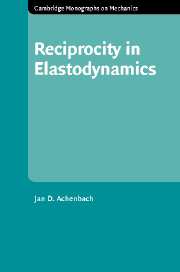Book contents
- Frontmatter
- Contents
- Preface
- 1 Introduction
- 2 Some elastodynamic theory
- 3 Wave motion in an unbounded elastic solid
- 4 Reciprocity in acoustics
- 5 Reciprocity in one-dimensional elastodynamics
- 6 Reciprocity in two- and three-dimensional elastodynamics
- 7 Wave motion guided by a carrier wave
- 8 Computation of surface waves by reciprocity considerations
- 9 Reciprocity considerations for an elastic layer
- 10 Forced motion of an elastic layer
- 11 Integral representations and integral equations
- 12 Scattering in waveguides and bounded bodies
- 13 Reciprocity for coupled acousto-elastic systems
- 14 Reciprocity for piezoelectric systems
- References
- Index of cited names
- Subject index
12 - Scattering in waveguides and bounded bodies
Published online by Cambridge University Press: 10 December 2009
- Frontmatter
- Contents
- Preface
- 1 Introduction
- 2 Some elastodynamic theory
- 3 Wave motion in an unbounded elastic solid
- 4 Reciprocity in acoustics
- 5 Reciprocity in one-dimensional elastodynamics
- 6 Reciprocity in two- and three-dimensional elastodynamics
- 7 Wave motion guided by a carrier wave
- 8 Computation of surface waves by reciprocity considerations
- 9 Reciprocity considerations for an elastic layer
- 10 Forced motion of an elastic layer
- 11 Integral representations and integral equations
- 12 Scattering in waveguides and bounded bodies
- 13 Reciprocity for coupled acousto-elastic systems
- 14 Reciprocity for piezoelectric systems
- References
- Index of cited names
- Subject index
Summary
Introduction
The scattering of elastic waves by defects, such as cracks, voids and inclusions, located in bodies with boundaries is a challenging topic for analytical and numerical studies in elastodynamics. It is, however, also a topic of great practical interest in the field of quantitative non-destructive evaluation (QNDE), because scattering results can be used to detect and size defects. In the context of QNDE, elastodynamics is referred to as ultrasonics, since it is generally necessary to work with wave signals whose principal frequency components are well above the frequency range audible to the human ear.
For realistic defects it is not possible to obtain solutions of scattering problems by rigorous analytical methods. The best numerical technique is generally the one that employs a Green's function to derive a boundary integral equation, as discussed in Chapter 11, which can then be solved by the boundary element method. This process yields the field variables on the surface of the scattering obstacle (the defect). An integral representation can subsequently be used to calculate the scattered field elsewhere. Of course, as an alternative, the fields on the defect can be approximated. Various approximations are available. We mention the quasistatic approximation for the displacement on the surface of a cavity, the Kirchhoff approximation for a crack and the Born approximation for scattering by an inclusion.
In Section 12.2 the interaction of an incident wave motion with a defect in a waveguide is considered. The incident wave is represented by a summation of modes.
- Type
- Chapter
- Information
- Reciprocity in Elastodynamics , pp. 199 - 219Publisher: Cambridge University PressPrint publication year: 2004

